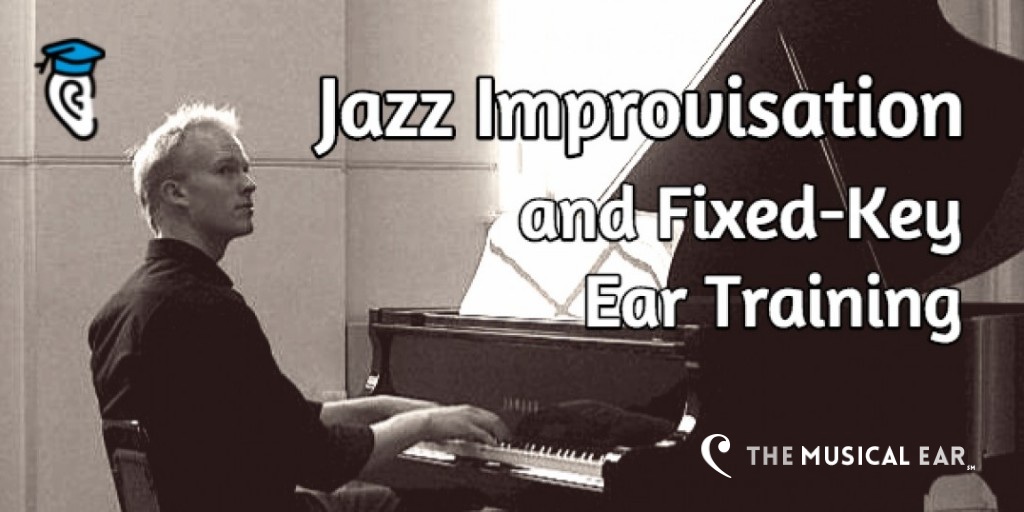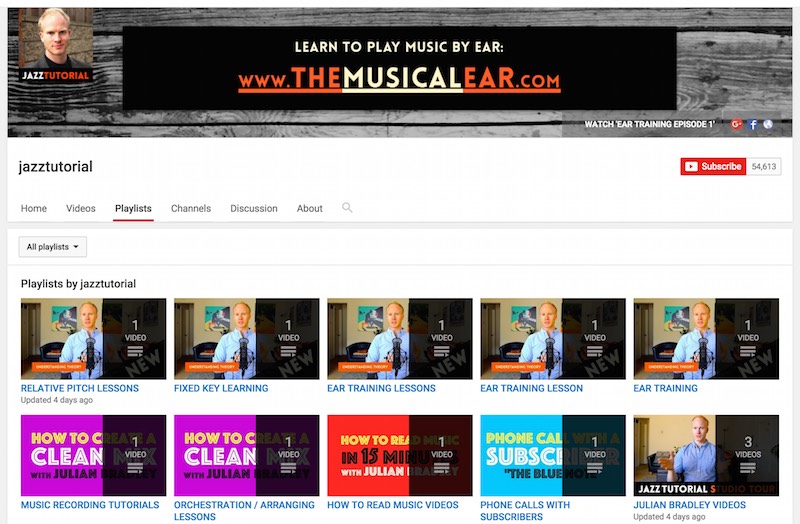Want to get amazing ears for improvising jazz music? We recently published an experts guide to starting jazz improvisation ear training and today we’re going in-depth with one of the contributors: Julian Bradley, the founder of the Jazz Tutorial YouTube channel and new ear training course The Musical Ear.

Hi, my name’s Julian Bradley. I have a masters degree in music composition, and I teach music theory and jazz piano through my ‘Jazz Tutorial’ YouTube channel.
I started playing piano at age 7, and studied classical piano until age 17. Shortly after completing my grade 8 piano exam, I attended a Wynton Marsalis jazz concert. This concert was my first exposure to jazz, and it sparked an obsession with the genre which I pursued intensely for the next 10 years. I studied jazz with several great teachers, read every book and blog post I could find on the subject, and transcribed many jazz songs by ear.
At the same time, I was continuing to study classical music and harmony at university for my undergrad and postgrad degrees.
Before writing “Jazz Theory Explained” I’d already been posting YouTube videos for three years, which meant I had my finger on the pulse as far as what people struggled with. I’d been receiving emails and comments daily, so I knew the common questions that needed to be addressed.
I’ve also read just about every book on jazz so I was well aware of what has and hasn’t been covered in other books, like Mark Levine’s and Phil DeGreg’s great books.
There were certain topics not covered in other books that aspiring jazz musicians tend to struggle with e.g. knowing which scale to play with any given chord, understanding a lead sheet and spotting a song’s key changes, how to write walking basslines under any progression – to name a few. So I made sure I covered these topics in depth.
The book focuses on jazz harmony (the tonal side of things), and I divided it into 5 sections:
- Understanding a lead sheet
- Chords / voicings
- Scales
- Jazz styles (Bossa Nova, Cuban, R’n’B)
- Advanced techniques.
I also embedded links to relevant videos of mine throughout the text – so it’s also an organization of my best video tutorials, all in one place.
When I look back on my musical development, it’s very clear that one skill has helped me more than any other – ear training.
“When I look back on my musical development, it’s very clear that one skill has helped me more than any other – ear training.”
At age 17 I made it a habit to transcribe songs by ear, and I taught myself relative pitch in a two-year period. When I did this, I noticed huge improvements in all other areas of my musicianship:
- My knowledge of theory increased (because I was learning every time I heard music played).
- My compositions got much better (because I could identify the music that was in my head).
- My improvisation got better (because I knew how notes would sound before playing them).
- And my confidence shot up.
When you look at the great musicians of all time, they come from a wide range of backgrounds – Beethoven, Mozart, Miles Davis, Pharrell Williams, etc. Some could read music, some could not. Some had formal training, some did not. However, they always have one skill in common – a phenomenal musical ear – meaning they either had perfect pitch or relative pitch to the highest level.
So I was clear that ear training is the most essential skill, for every musician to work on. All musicians can learn it – they just have to practice it the right way.
“Ear training is the most essential skill, for every musician to work on. All musicians can learn it – they just have to practice it the right way.”
Making the course was a huge project for me, but long story short – I ended up mapping out my own exact path I’d taken to train my ear. I teach people exactly what I learnt, in the exact same order. First we work on diatonic music (music which stays within the key), and then gradually we branch out into “out of key” techniques – including modulation, the modes, jazz, and more.
The biggest barrier preventing most musicians from mastering relative pitch, is that they continually play in different keys. The Musical Ear is the only course (as far as I know) that teaches everything in the same key, from beginning to end. I call this method “fixed key learning” and I discovered it completely by accident.
When I was first transcribing songs by ear, I chose to transcribe them all in the same key – which happened to be E♭ major / C minor. When you transcribe each new song within the same key, it’s very easy to spot the recurring patterns. Roughly 80% of music is built of the same 7 notes and 6 chords – the only thing changing is usually the key signature.
When I started restricting my playing to one key (in my case for a whole year), I noticed huge improvements in my ear training, and in my understanding of music theory. And only recently when I was creating the course, did I realize that focusing on one key had played an essential role in my learning.
I explain the various benefits of fixed-key learning in episode 1 of the course, which you can watch here:
And as far as who’s best suited for the course – ear training is the most essential skill for every musician, whatever their interest – performance or composition, professional or hobby. For this reason I made the course relevant to all instruments (piano, guitar, bass, vocal, etc). Some exercises are piano based but can be adapted for any instrument. Reading music is not necessary.
That said, the course is not for complete beginners, and I recommend five years playing as a minimum. Having a good understanding of the 12 intervals, and the major and minor scales before you start will also help.

My goal will always be to help musicians reach their full musical potential. Music can be a very special part of someone’s life: a whole extra dimension that a lot of people don’t know even exists. I want to give aspiring musicians the same opportunities I had, by making the world class education I had available to anyone who has the passion to learn.
I’m clear that ear training will always be the most essential skill any musician can develop – whether now, or 500 years from now – so for the immediate future I’m doing everything I can to raise awareness around this subject.
But beyond my ear training work, I’m starting to think bigger than individual lessons on one-off topics, which is what I’ve done until now. I want to connect the dots by developing complete practice plans for musicians to follow, showing them what to practice and in what order.
You can watch episodes one and two of my ear training course for free on my website:
And you can subscribe to my youtube channel where I have over 100 tutorial videos at:
Thank you Christopher for having me!
Stay tuned for more in-depth interviews with jazz ear training experts. If you’re intrigued by “fixed-key” ear training, be sure to check out this page where you can learn more – and don’t miss subscribing to Julian’s top-notch YouTube channel for jazz piano tutorials and more.








